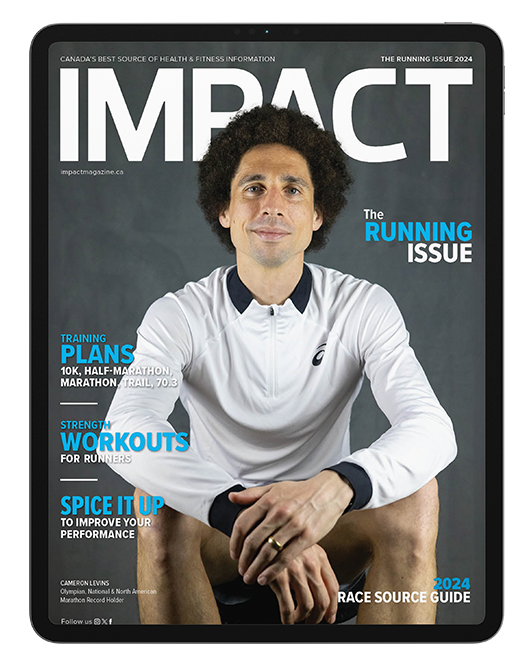During the height of Covid I was in a running rut, doing the same routes in my neighbourhood, slogging away at the same pace. As I’ve always paid attention to my cadence, one day (largely out of curiosity) I counted my steps. I was shocked to find that in one minute my step count was 170 steps, lower than my usual 180.
What had happened? My body had clearly adjusted to this slower pace and I had lost that quickness in my feet without realizing it. I decided to add a weekly interval training session to find my previous leg speed and build back my running efficiency.
Why Run Intervals
On a physiological level, intervals improve your aerobic and anaerobic endurance, increase your VO₂ max and improve your running performance. The increased load and stimulus on the muscles and connective tissues also improves strength and promotes training adaptations.
If you’re short on time, intervals are efficient and a great way to have a quality workout in a short session. You can throw a few bouts into one of your midweek shorter runs and see some change in your performance in several weeks.
Once I added intervals back into my Covid training, within a couple of months my step count improved, even on my easy runs. I found that increasing my cadence with interval work helps my legs land under my hips naturally, without overthinking the mechanics. My heart rate also lowered on my runs, demonstrating improvements in capacity.
How you incorporate intervals into your training cycle depends on your racing goals and distances; they will benefit each athlete differently. If you are racing short, such as three to five kilometres, then including intervals about eight weeks before tapering will provide good specificity of training to racing. For longer events like a half-marathon or marathon, adding intervals in your base-building phase three to four months prior to your event will help develop early leg speed and running economy. For a 10-kilometre race, intervals can be scheduled six to eight weeks before tapering; however, the duration and intensity should mimic the race speed with slightly longer sets such as one-kilometre repeats at race pace.
Interval Tips
Build a base:
Beginners to advanced runners can benefit from speed work and all levels will be well served by having a good aerobic base of easy running before diving into interval training. This allows your body to adapt before applying greater physical demands.
Start with Strides:
One of my favourite ways to introduce speed is with strides. Strides are an acceleration, where you start at a moderate pace and gradually increase your speed over about 75 to 100 steps or metres. I prefer to use steps and count each one and pick up my turnover about every 25 steps. I focus on running with excellent form, staying tall, picking up my knees and driving my arms. Try to find a softer surface such as grass or dirt to run strides as this will be gentler on your body.
Preparation:
Thorough warm-ups and cool downs are crucial for a safe and effective speed session. The higher the intensity of the workout, the longer the warm-up. Make sure to jog for at least 15 to 20 minutes and then perform drills and strides, run your main set, and then cool down for another 10 to 15 minutes.
Where and How:
Run your intervals on flat ground. You can choose an uninterrupted road or head to the track. The duration of your intervals and rest periods will vary depending on the intensity. Shorter efforts at a very high intensity (95 per cent or more of maximum) require roughly double to triple the amount of rest/work at 2:1 or 3:1. Longer intervals at a slightly lower intensity (90 to 95 per cent) need a bit less, at a ratio of 1:1 or 2:1. For example, if you run at almost maximum effort for one minute, this would require an active recovery jog of two minutes. If the duration was longer at three to five minutes, and the intensity less, a recovery of three to five minutes would be sufficient.
Beyond all the scientific reasons for running intervals, they are also a ton of fun. What’s not to love about that amazing lift you get when you pick up your feet, drive your arms and feel that ‘flow’ and lightness in your step? Every runner would benefit by including some form of intervals into their training throughout the year.
Sample Interval Workouts
Segue Into Intervals with Strides
- Run on a grass or dirt field.
- Warm-up running easy for 15 – 20 minutes.
- Run 5 – 10 x 75 strides.
- Strides are an acceleration. Start at about 75 per cent of max effort and build to about 90 per cent. This is not a sprint!
- 75 strides = 75 steps.
- Run easy or walk back to your start position.
- Cool down running easy 10 – 15 minutes.
Fartlek:
- Warm-up running easy for 15 – 20 minutes.
- Run 1 – 2 sets of running drills like ABC’s.*
- Run 3 x 75 strides.
- Run 21 minutes non-stop at:
- 1-minute fast at 90 per cent effort
- 1-minute easy at 65 per cent effort
- Cool down running easy 10 – 15 minutes.
Track/Road 400’s - Warm-up running easy for 15 – 20 minutes.
- If running on the track do warm-ups, recoveries, and cool downs in clockwise direction.
- Run 1 – 2 sets of running drills like ABC’s.
- Run 3 x 75 strides.
- Run 6 – 10 x 400 metres fast, at 90 per cent effort.
- If running on the road, do 6 – 10 x 90 seconds.
- Run 400 metres easy or about two minutes if you are on the road.
- Cool down running easy 10 – 15 minutes.
*For an explanation of ABC drills go to: Incorporate Running Drills to Find Your Form
You may also like: Running by Effort

Read This Story in Our 2024 Running Issue
Featuring Canadian Olympic, National & North American Marathon Record holder Cameron Levins. Run your way around the world with some cool, quirky and unconventional races. Train for 10 km right up to a marathon – plus a 25 km trail run and 70.3 program. Strength workouts for runners, spice it up to improve your performance and so much more.

















